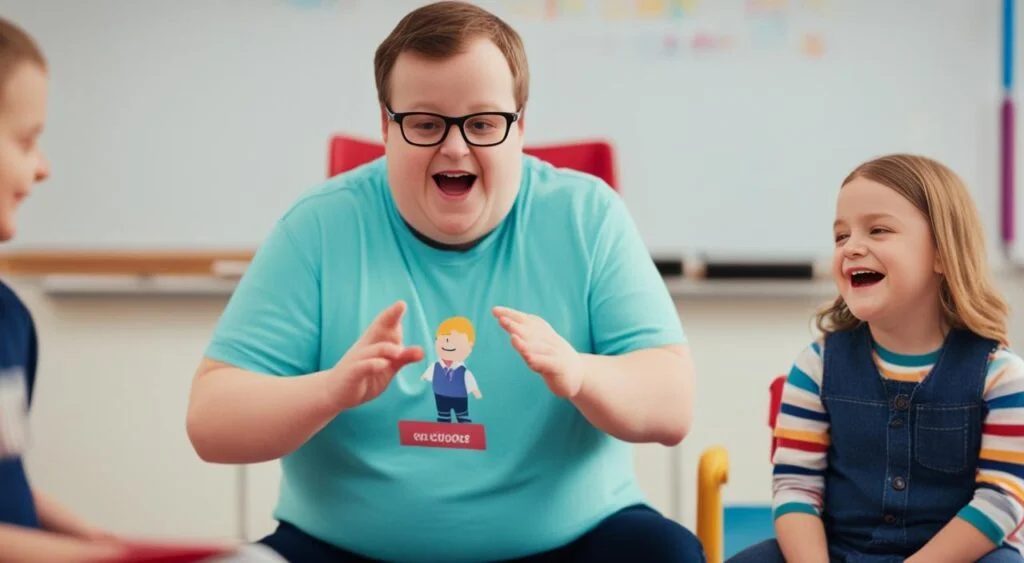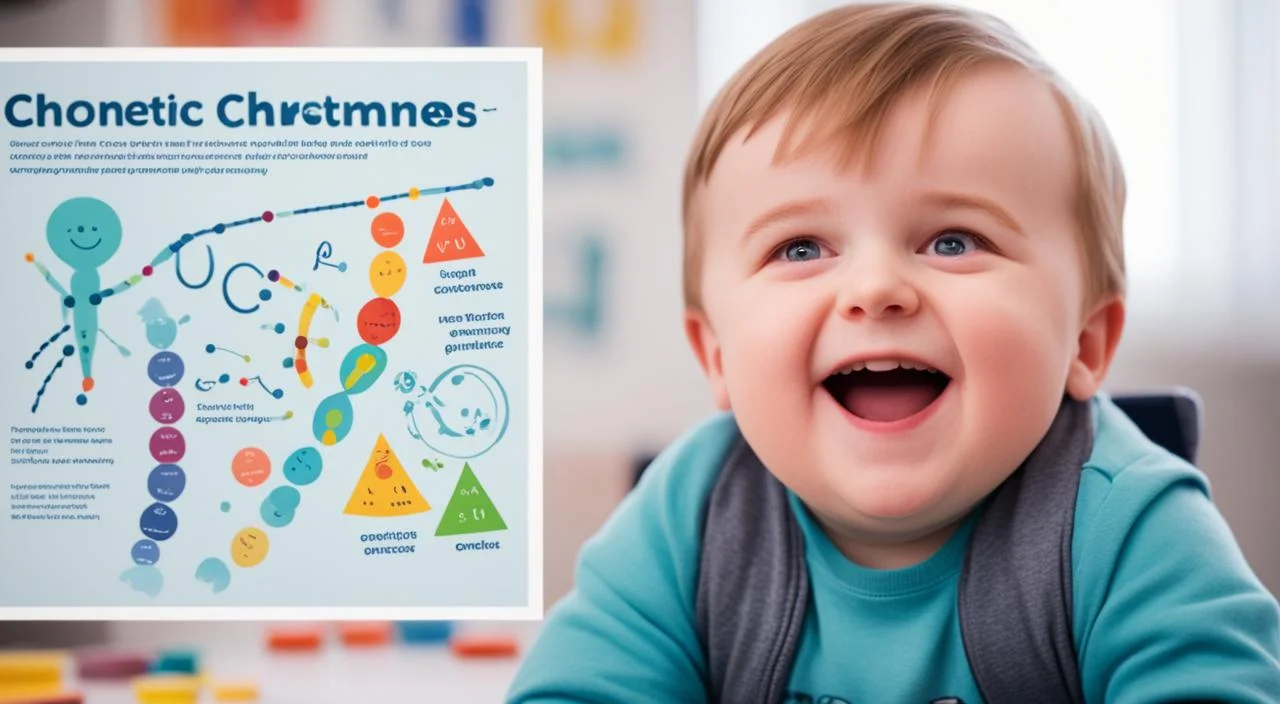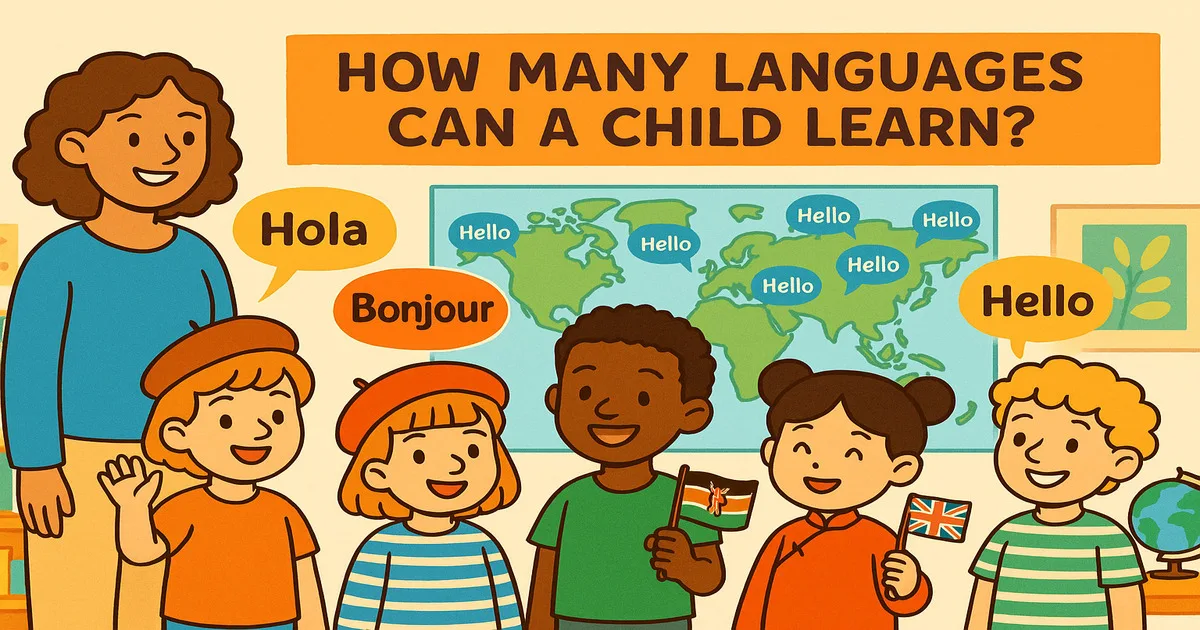Down syndrome is a chromosomal disorder that affects individuals by having an extra copy of the 21st chromosome. Explaining this condition to a child in an age-appropriate manner can help them understand and embrace differences.
It’s important to start by explaining chromosomes to the child, comparing them to puzzle pieces that determine various characteristics like eye color and hair type. For kids with Down syndrome, some physical features may include almond-shaped eyes, a flat nose bridge, and a smaller stature compared to their peers.
Children with Down syndrome may also take longer to learn to talk and walk, but it’s crucial to emphasize that they desire the same things as any other child. They want to belong, make friends, play, learn, and have fun. By teaching children about Down syndrome, we can promote understanding, empathy, and acceptance.
Key Takeaways:
- Down syndrome is a chromosomal disorder characterized by having an extra copy of the 21st chromosome.
- Chromosomes are like puzzle pieces that determine various characteristics.
- People with Down syndrome may have unique physical features.
- Children with Down syndrome may take longer to learn certain skills, like talking and walking.
- Acknowledging the desires and abilities of individuals with Down syndrome is crucial for fostering inclusion and understanding.
Teaching Kids About Down Syndrome
To help children understand and embrace the concept of Down syndrome, using age-appropriate books can be an effective approach. Books such as “Hannah’s Down Syndrome Super Powers” and “This Is Ella” are highly recommended resources for introducing Down syndrome to children in a kid-friendly manner.
These books not only explain the condition but also emphasize the similarities between children with Down syndrome and their peers. By highlighting the unique strengths and abilities of individuals with Down syndrome, children can develop a better understanding and appreciation for their differences.
Encouraging children to ask questions is vital in fostering an inclusive and accepting environment. It’s essential to create a space where kids with Down syndrome feel valued and supported, promoting open dialogue and curiosity.
Children are naturally curious, and addressing their questions about Down syndrome with patience and empathy can help build awareness and compassion.
By incorporating these educational resources and cultivating an environment that encourages acceptance, children can learn to appreciate diversity and develop meaningful connections with individuals who have Down syndrome.
Recommended Books:
- “Hannah’s Down Syndrome Super Powers” by Marquita Fraser
- “This Is Ella” by Sally Anne Garland
Visual aids, such as illustrations and photographs, can further enhance the learning experience for children. The provided image captures the essence of teaching kids about Down syndrome, showcasing the joy and inclusivity that can be found in these relationships.
| Benefits of Teaching Kids About Down Syndrome | Tips for Effective Teaching |
|---|---|
| Encourages empathy Fosters acceptance and inclusion Educates about genetic diversity Promotes understanding of different abilities Creates a more inclusive society | Use age-appropriate language and explanations Encourage questions and provide accurate answers Utilize storytelling and visual aids Model acceptance and inclusivity Collaborate with teachers to integrate lessons |
By incorporating these strategies into teaching, we can empower children with the knowledge and understanding needed to foster compassion, inclusivity, and respect.
Answering Common Questions
Children are naturally curious and may have questions about why people with Down Syndrome are different from others. It’s important to provide them with honest and age-appropriate explanations that help them understand and embrace diversity.
When discussing Down Syndrome with children, it can be helpful to start by explaining that people with Down Syndrome have 47 chromosomes instead of the usual 46. Chromosomes are like puzzle pieces that determine various characteristics in our bodies, such as eye color and hair type. Individuals with Down Syndrome have an extra copy of the 21st chromosome, which can result in physical and developmental differences.
Encourage children to see these differences as unique qualities that make each person special, rather than something that sets them apart. Emphasize that despite these differences, everyone deserves to be treated with kindness, respect, and acceptance.
When answering children’s questions, use simple language that they can understand. Here are a few common questions children may ask about Down syndrome, along with suggested responses:
- Why do some people with Down syndrome look different?
People with Down syndrome may have distinctive facial features, such as almond-shaped eyes and a flat nose bridge, that can make them look different from others. It’s important to remember that appearance doesn’t define a person’s worth or abilities. We should appreciate and accept everyone, regardless of their physical appearance. - Why do some people with Down syndrome learn and speak differently?
Children with Down syndrome may take longer to learn to talk and walk because their development may be delayed. But that doesn’t mean they can’t communicate with or understand others. We should be patient and supportive, allowing them to learn at their own pace and communicating with them in ways that they can understand. - Can people with Down syndrome go to school and have friends?
Absolutely! People with Down syndrome can attend school just like any other child. They enjoy learning, making friends, and participating in activities. It’s important for us to include and be friends with individuals with Down Syndrome, as they have so much to offer and can enrich our lives in many ways.
Remember, creating an inclusive and accepting environment starts with open and honest conversations. Answering children’s questions about Down Syndrome helps them develop empathy, understanding, and acceptance towards others.
Creating awareness and educating children about Down Syndrome is essential in building a compassionate and inclusive society that values diversity.
Promoting Inclusion and Friendship
Teaching children about inclusion and friendship is essential when it comes to understanding Down syndrome. By encouraging kids to include children with Down syndrome in their activities and playdates, they can develop meaningful and supportive friendships.
- Help children understand that making friends with someone who has Down syndrome can be just as rewarding and fun as any other friendship.
- Emphasize the value of empathy, compassion, and understanding in fostering inclusive relationships.
“Friendship is about embracing our differences and celebrating our unique qualities. By including children with Down syndrome, we create a community that values acceptance and diversity.”
Teaching children about inclusion also provides an opportunity to challenge stereotypes and misconceptions. By offering a supportive environment, kids can learn to appreciate and respect individuals with Down syndrome for who they are.
Benefits of Inclusion and Friendship
When children understand Down syndrome and include individuals with this condition in their lives, they gain valuable experiences and benefits:
| Benefits of Inclusion and Friendship |
|---|
| 1. Enhanced empathy and understanding |
| 2. Increased tolerance and acceptance of differences |
| 3. Improved social skills and communication |
| 4. expanded worldview and appreciation for diversity |
| 5. stronger sense of community and belonging |
Approaching the Topic with Teachers and Classmates
When it comes to discussing Down syndrome in the classroom, it’s important to approach the topic with sensitivity and guidance. Start by initiating a conversation with your child’s teacher to determine the appropriate approach and timing. Collaborating with educators can help ensure that the topic is introduced in a way that promotes understanding and inclusivity.
Consider suggesting the idea of reading a book about differences as a classroom activity. This can provide a gentle and age-appropriate introduction to explaining genetic disorders to children, including Down syndrome. Some recommended books include “We’ll Paint the Octopus Red” by Stephanie Stuve-Bodeen and “My Friend Isabelle” by Eliza Woloson. These stories can help children understand that everyone is unique and valuable, regardless of their differences.
Engaging in activities that promote understanding of speech or fine motor challenges can also be beneficial. This could include inviting guest speakers who have personal experiences with Down syndrome or arranging interactive exercises that simulate certain challenges. By creating hands-on learning opportunities, children can gain a deeper understanding of the communication and physical differences that individuals with Down syndrome may experience.
It’s also important to encourage the use of person-first language when discussing Down syndrome. This means emphasizing the person before the disability, such as saying “a person with Down syndrome” instead of “a Down syndrome child.” Person-first language helps to respect and acknowledge the individuality of each person, fostering a more inclusive and compassionate classroom environment.
To create a supportive classroom atmosphere, encourage open communication and collaboration among all stakeholders. This includes not only teachers and students but also the principal, guidance counselor, and other parents. By working together, you can create an environment that embraces diversity, educates students about Down syndrome, and promotes empathy and acceptance.
Remember, talking to kids about Down syndrome and explaining genetic disorders to children may seem challenging at first, but with the right approach and support, it can foster understanding, compassion, and inclusivity in the classroom and beyond.
Addressing Myths and Stereotypes
Children may encounter myths and stereotypes about Down syndrome. It is essential to address these misconceptions and provide factual information to dispel any misunderstandings. By doing so, we can promote understanding and create a more inclusive society.
One common myth is that individuals with Down syndrome are less capable or intelligent than others. In reality, people with Down syndrome have unique abilities and talents, just like anyone else. It’s crucial to teach children that intelligence comes in various forms and everyone deserves respect and dignity.
“People with Down syndrome may have cognitive delays, but they also have diverse strengths and talents.”Down Syndrome Education International
Another myth is that individuals with Down syndrome are always happy. While people with Down syndrome may have a generally positive outlook, they experience a range of emotions, just like anyone else. It’s important to recognize and validate their feelings, treating them as individuals with their own unique experiences.
It’s also necessary to address the derogatory language associated with Down syndrome, such as the use of the “R-word.” Teach children that using such language is hurtful and disrespectful. Encourage them to choose words that promote empathy and understanding, fostering an inclusive environment where everyone feels valued.
To promote positive attitudes and awareness, engage children in open conversations about Down syndrome. Encourage them to ask questions and listen without judgment. Provide age-appropriate explanations, using simple language that they can comprehend. By promoting education and empathy, we can break down stereotypes and create a more inclusive society.
Teaching Empathy through Stories
Books can be powerful tools for teaching children about Down syndrome and fostering empathy. Here are a few recommended titles:
- The Great Big Book About Down Syndrome by Dale Koppel
- 47 Strings: Tessa’s Special Code by Becky Carey
- I’m Here, by Peter H. Reynolds
These books provide age-appropriate explanations, personal stories, and positive role models to help children understand and appreciate the experiences of individuals with Down syndrome.
By addressing myths and stereotypes about Down syndrome, we can foster a society that embraces diversity and inclusion. It is through education, open conversations, and empathy that we can break down barriers and create a world where everyone is valued for who they are.
Resources and Support

When it comes to understanding Down syndrome and providing education for kids, there are numerous resources and support networks available. Whether you are a parent, teacher, or simply interested in learning more, these resources can offer valuable information, guidance, and a sense of community.
Online Resources
Online platforms provide a wealth of information and support for understanding Down syndrome. Websites such as the National Down Syndrome Society (NDSS) and the Global Down Syndrome Foundation offer articles, publications, and educational materials that cover a wide range of topics related to Down syndrome education for kids and understanding Down syndrome for children. By exploring these resources, you can gain a deeper understanding of the condition and find strategies to support children with Down syndrome.
Books
Books can be powerful tools for teaching kids about Down syndrome and promoting inclusivity. There are several well-loved books available that accurately depict the experiences and abilities of individuals with Down syndrome. Some recommended titles include:
- “Hannah’s Down Syndrome Super Powers” by Jennifer Moore-Mallinos
- “This Is Ella” by Jennifer Drez
These books not only help children understand Down syndrome but also encourage empathy, respect, and kindness towards individuals with the condition.
Social Media
Social media platforms provide an opportunity to connect with individuals and families who have firsthand experience with Down syndrome. By following accounts that feature individuals with Down syndrome and their family members sharing their life experiences, you can gain insights, find support, and discover inspiring stories. Social media platforms such as Instagram and Facebook are particularly popular for this purpose.
It’s important to note that while social media can be a valuable resource, it’s essential to verify the credibility of the information shared. Cross-referencing with reputable sources and organizations can ensure accurate and reliable information.
Local Down Syndrome Associations and Organizations
Connecting with local Down syndrome associations and organizations can provide further guidance, workshops, and support for both parents and educators. These associations often offer resources specific to your community and can help you navigate the education system, find specialized services, and connect with other families.
By utilizing these resources and support networks, you can enhance your understanding of Down syndrome and provide the necessary support and education to children. Remember, each child with Down syndrome is unique, and by embracing their individuality, we can foster an inclusive and accepting environment that celebrates diversity.
Conclusion
Explaining Down syndrome to a child is an important aspect of fostering inclusivity and understanding. By approaching the topic in a simple and age-appropriate manner, we can help children grasp the concept and develop empathy towards individuals with Down syndrome. It is crucial to emphasize that people with Down syndrome have unique qualities and abilities, just like any other child.
In our efforts to promote inclusion and acceptance, we should encourage children to treat individuals with Down syndrome with kindness and respect. By fostering open conversations and creating an inclusive society, we can help children develop compassion and build meaningful connections with individuals with Down syndrome.
Remember, it is through education and understanding that we can break down barriers and create a world where children of all abilities are valued and respected. By teaching our children about Down syndrome and promoting empathy, we are taking a significant step towards building a more inclusive future.
FAQ
How can I explain Down syndrome to a child in an easy way?
Down syndrome is a chromosomal disorder caused by having an extra copy of the 21st chromosome. We all have chromosomes that determine different things about us, like our eye color and hair type. People with Down syndrome have some physical and developmental differences, but they still want to play, learn, and have fun, just like any other child.
How can I teach kids about Down syndrome?
You can use age-appropriate books that explain Down syndrome in a kid-friendly way. Books like “Hannah’s Down Syndrome Super Powers” and “This Is Ella” are great options. It’s important to highlight that people with Down syndrome have unique strengths and abilities. Encourage children to ask questions and create an inclusive environment where kids with Down syndrome feel valued and supported.
Why do people with Down syndrome look different?
People with Down syndrome have 47 chromosomes instead of the usual 46, which can lead to physical and developmental differences. These differences make each person special and unique. It’s important to treat everyone with kindness and respect, regardless of how they look.
How can I teach my child about inclusion and being friends with someone with Down syndrome?
Encourage your child to include children with Down syndrome in their activities and playdates. Help them understand that making friends with someone who has Down syndrome can be just as rewarding and fun as any other friendship. Teach them the value of empathy, compassion, and understanding.
How should I approach the topic of Down syndrome with teachers and classmates?
Before discussing Down syndrome in the classroom, talk to your child’s teacher about the best approach and timing. Consider reading a book about differences, engaging in activities that promote understanding of speech or fine motor challenges, and using person-first language. Collaboration with the principal, guidance counselor, and other parents can help create a supportive classroom environment.
How can I address myths and stereotypes about Down syndrome?
Provide factual information about Down syndrome to address misconceptions. Teach children to use respectful language and to treat individuals with Down syndrome with dignity. Encourage open conversations, education, and empathy to promote awareness and positive attitudes.
Where can I find resources and support related to Down syndrome?
There are various online resources, books, and social media accounts that provide valuable information and support about Down syndrome. Consider following social media accounts featuring individuals with Down syndrome sharing their experiences. Connect with local Down syndrome associations and organizations for guidance, workshops, and support.
In conclusion, how can I explain Down syndrome to a child?
Explain to children that people with Down syndrome have unique qualities and abilities. Encourage inclusion, empathy, and understanding. By fostering acceptance and open conversations, we can help children develop compassion and create an inclusive society where individuals with Down syndrome are valued and respected.





